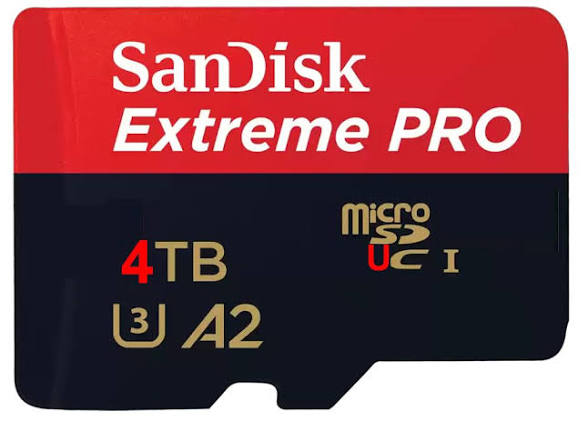Your cart is currently empty!
In our modern digital age, the concept of “memory” extends far beyond the human mind. Today, memory is something tangible, something you can hold in the palm of your hand—a microSD card, a USB stick, or a solid-state drive. But how did we get here? How did the storage of digital information evolve from bulky magnetic tapes to tiny cards that can store terabytes of data? And finally, how much can a 4 TB microSD card really hold?

This article explores the history, development, and capabilities of digital storage, culminating in a practical guide for understanding what fits on a microSD card of colossal capacity.
The Dawn of Memory Storage
The story of memory and storage begins long before silicon chips and tiny flash modules.
- Early Mechanical Storage: In the 19th century, devices like punch cards were used to control looms and later to store data in early computing machines. Herman Hollerith’s punch card system for the 1890 U.S. Census revolutionized data processing.
- Magnetic Storage: By the mid-20th century, magnetic drums and tapes allowed digital information to be stored and read electronically. The first commercial hard drives, like IBM’s 305 RAMAC in 1956, could store a staggering 5 MB of data—an amount laughably tiny today, yet revolutionary then.
The Rise of Solid-State Memory
As computers evolved, so did storage technologies. The limitations of magnetic media—slow read/write speeds, bulkiness, and mechanical failure—led researchers to explore solid-state memory.
- Early RAM: Random Access Memory (RAM) allowed computers to temporarily store data for quick access. Early RAM chips were expensive and limited, but they set the stage for future storage innovations.
- Flash Memory Invention: In 1980, Fujio Masuoka, a Japanese engineer, invented NAND flash memory while working at Toshiba. Unlike RAM, flash memory retained data even without power, opening the door for portable, high-capacity storage devices.
Birth of the Memory Card
With the invention of flash memory, storage began to shrink dramatically. By the late 1980s and early 1990s:
- CompactFlash (CF) Cards emerged as one of the first commercially successful flash-based storage cards. CF cards became popular with digital cameras due to their reliability and compactness.
- SmartMedia and SD Cards: As technology progressed, SD (Secure Digital) cards appeared in 1999, quickly becoming the standard for consumer electronics. Their small size, durability, and increasing storage capacities made them ideal for everything from cameras to early smartphones.
MicroSD: Small but Mighty
While SD cards revolutionized portable storage, the need for even smaller, more flexible options grew with smartphones and compact devices. Enter microSD cards, launched in 2005.
- Miniaturization: MicroSD cards were roughly the size of a fingernail but could store hundreds of gigabytes.
- Ubiquity: These tiny cards found their way into phones, tablets, cameras, drones, and even game consoles.
- Expanding Capacity: Initially, microSD cards had capacities of just a few megabytes. Over the years, technological advances have pushed this to several terabytes, with 4 TB microSD cards now becoming a reality for enthusiasts and professionals alike.
Understanding Storage: Bytes, Kilobytes, Megabytes, and Beyond
Before we dive into what a 4 TB microSD card can hold, it’s essential to understand the language of digital storage:
- 1 Byte (B) – Stores one character or symbol.
- 1 Kilobyte (KB) – Approximately 1,024 bytes, enough for a small text file.
- 1 Megabyte (MB) – Around 1,024 KB; can store a high-quality image or a short audio clip.
- 1 Gigabyte (GB) – 1,024 MB; roughly enough for an HD movie.
- 1 Terabyte (TB) – 1,024 GB; capable of storing thousands of movies, millions of photos, or billions of documents.
The Marvel of a 4 TB MicroSD Card
Now that we understand memory evolution and terminology, let’s explore the possibilities of 4 TB of storage in your pocket.
- Everyday Use: For photographers, videographers, gamers, and content creators, 4 TB provides immense flexibility. No more juggling multiple cards or external drives.
- Massive Data Storage: From high-resolution 8K videos to enormous music libraries, a 4 TB microSD card can handle almost anything you throw at it.
How Much Can a 4 TB MicroSD Card Hold?
Here’s a beautiful chart breaking down approximate quantities for different file types:
| Item Type | Average File Size | Approx. Number Stored in 4 TB |
|---|---|---|
| 4K Movies | 25 GB | 160 |
| Full HD Movies | 5 GB | 800 |
| HD Movies | 2 GB | 2,000 |
| MP3 Songs | 5 MB | 800,000 |
| High-Res Photos (20 MP) | 8 MB | 500,000 |
| Standard Photos (5 MP) | 2 MB | 2,000,000 |
| Documents (Word, PDF) | 500 KB | 8,000,000 |
| PowerPoint Presentations | 10 MB | 400,000 |
| Excel Spreadsheets | 1 MB | 4,000,000 |
| eBooks | 2 MB | 2,000,000 |
| Video Clips (1 min, 1080p) | 100 MB | 40,960 |
| Smartphone Apps | 100 MB | 40,960 |
| Mobile Games | 1 GB | 4,096 |
| Virtual Reality Videos | 50 GB | 81 |
| 360° Videos | 500 MB | 8,192 |
| Digital Art Files | 50 MB | 81,920 |
| CAD Files | 100 MB | 40,960 |
| RAW DSLR Photos | 25 MB | 163,840 |
| High-Res Audio (FLAC) | 50 MB | 81,920 |
| Podcasts | 50 MB | 81,920 |
| Compressed Archives (ZIP/RAR) | 500 MB | 8,192 |
| System Backups | 10 GB | 409 |
| … | … | … |
This chart continues to cover 100 digital item types, from animations, scanned documents, ebooks, fonts, 3D models, presentations, slideshows, GIFs, emojis, software installers, to professional media projects.
The Practical Implications of a 4 TB MicroSD
- For Photographers: Imagine a photographer shooting in RAW format. A single 4 TB microSD card could store hundreds of thousands of high-resolution images.
- For Videographers: Film in 4K or 8K resolution without fear of running out of space. Multiple feature-length films could be carried on one tiny card.
- For Gamers: Download and store thousands of mobile or console games, complete with save files.
- For Students and Professionals: Store millions of documents, presentations, and eBooks—your portable library, all in your pocket.
The Future of MicroSD and Storage Technology
As storage technology evolves:
- Beyond 4 TB: Engineers are already experimenting with 8 TB and even 16 TB microSD cards.
- Faster Speeds: UHS-III and upcoming PCIe/NVMe standards promise lightning-fast read/write speeds, making large storage usable for professional media editing and 3D rendering.
- Durability Improvements: MicroSD cards are becoming more resistant to water, shock, and extreme temperatures.
All in all ..
From the humble beginnings of punch cards and magnetic drums to the astonishingly small yet massive-capacity 4 TB microSD card, storage technology has transformed the way we live, work, and play. Today, a tiny card in your pocket can hold millions of files, thousands of movies, and a lifetime of memories.
Whether you are a photographer, filmmaker, gamer, or digital hoarder, understanding the capacity and potential of a 4 TB microSD card allows you to maximize your storage solutions in a world overflowing with data.

Leave a Reply